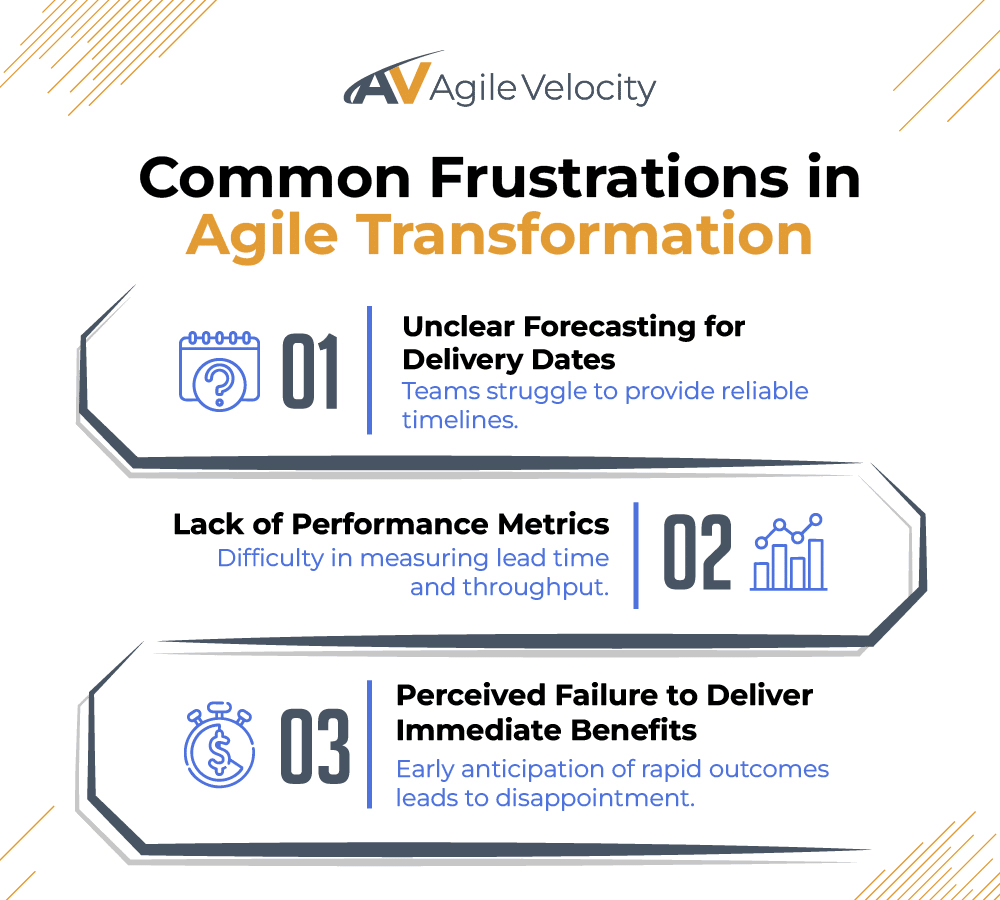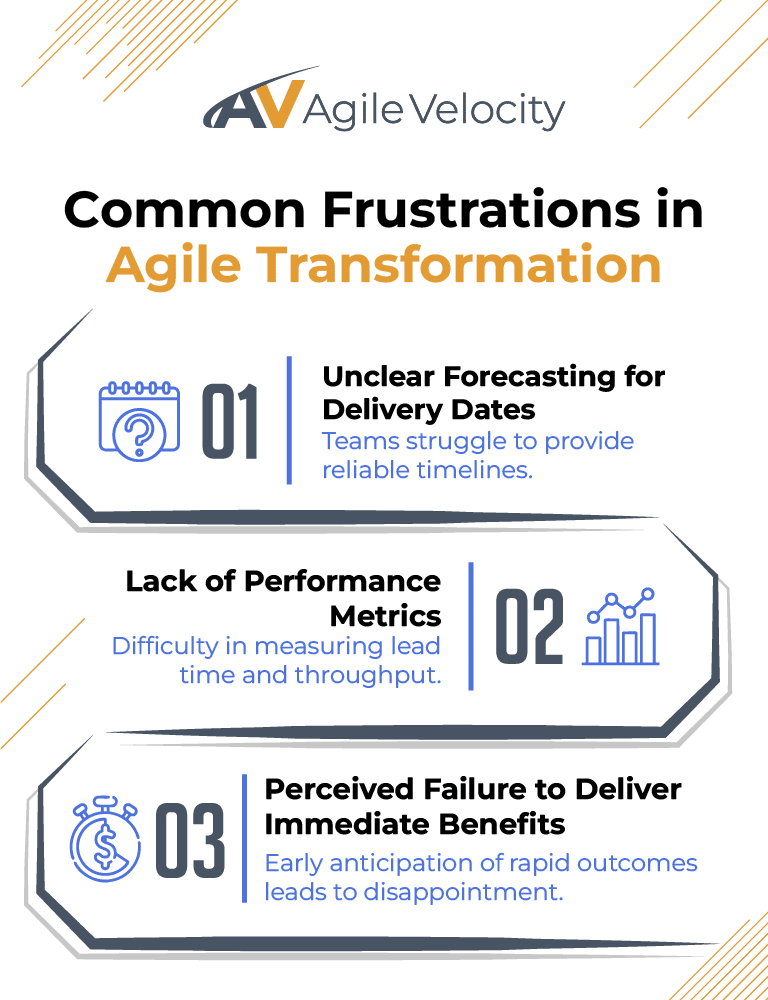Agile Transformation promises faster delivery, improved quality, and empowered teams. Yet many organizations find themselves frustrated when expectations aren’t met. Teams may adopt frameworks like Scrum or Scaled Agile Framework® (SAFe®) but still experience delayed delivery, unclear performance metrics, and stagnant team dynamics.
This article examines why Agile Transformations often fall short and offers practical strategies to create measurable, lasting improvements.
By shifting focus to outcome-based goals with guidance from Agile Velocity and tracking key metrics with their Path to Agility® Navigator software, organizations can transform frustrations into opportunities for real progress.
Why Agile Transformations Often Fall Short
Many organizations encounter roadblocks that prevent Agile Transformations from reaching their full potential. It is important to recognize that successful Agile adoption is as much about creating an adaptive culture as it is about implementing processes and tools.
The Challenge of Initially Adopting Agile Effectively
Successful Agile Transformations require more than following rituals; they demand a shift in mindset and culture.
For Agile to succeed, leaders and team members must embrace a mindset shift. Agile flourishes when everyone understands its core principles—iterations, collaboration, continuous learning—and stays committed to the journey. By recognizing when and why Agile efforts stall, organizations can address the real roadblocks and reignite their pursuit of faster value delivery.
Common adoption issues include:
- Mindset Over Rituals: Checking boxes on events like Sprint Planning or Retrospectives without embracing core Agile principles results in superficial practice. Key to overcoming this is ensuring that the team and leadership truly internalize Agile values and practices. For example, understanding foundational guidance—as detailed in the Scaled Agile Framework (SAFe) Values & Principles—is essential.
- Resistance to Change: If leadership clings to traditional methods or fails to empower teams, the necessary cultural shift will not materialize. Transforming an organization requires not only adopting new practices but also unlearning entrenched habits that do not add value.
- Lack of Outcome-Based Goals: Without clearly defined, measurable objectives that align with strategic priorities, teams end up focusing on task completion rather than delivering business value. This gap results in a misallocation of resources and sustained frustration when anticipated benefits are not realized.
One frequent stumbling block is expecting Agile to fix everything overnight without establishing a supportive foundation. Leaders might tell teams to “be Agile,” but fail to offer the necessary guidance or rationale. Meanwhile, teams often rebrand existing meetings using agile terminology like the Daily Scrum or shift to a Kanban Board without adopting the mindset or practices that make it effective. Beneath this surface-level adoption, legacy habits remain unchanged, causing teams to dismiss Agile as ineffective.
It’s also easy to fall into the trap of adopting the trappings of Agile—like shorter development cycles or new ceremonies—without digging deeper into the cultural changes needed. Leaders may focus on metrics alone, forgetting that Agile emphasizes team empowerment and rapid customer feedback.
The Most Common Frustrations During the Journey
In addition to the adoption challenges discussed above, these are some common frustrations teams face once they are deeper into their transformation journey:
- Unclear Forecasting for Delivery Dates – Teams struggle to provide reliable timelines, leaving stakeholders uncertain about when features will be completed. This uncertainty not only frustrates customers but also hampers internal planning, causing ripple effects across the organization.
- Lack of Performance Metrics – Without meaningful metrics such as lead time, throughput, or collaboration, it becomes difficult to assess progress and drive data-driven improvements. A deficiency in clear, actionable data makes it challenging to justify Agile investments at the executive level, as the connection between Agile practices and business results appears blurred.
- Perceived Failure to Deliver Immediate Benefits – Some teams initially anticipate rapid positive outcomes from Agile practices, such as Daily Scrums or Sprint events. However, in many cases, realizing tangible benefits requires time and a clear alignment with organizational goals. When early routine practices do not produce immediately measurable outcomes, it may lead to caution or a need to adjust expectations rather than a universal loss of confidence in Agile. Recognizing and managing these expectations is essential for long-term success.
“We tried Agile, and it didn’t work.” This statement is more frequent than you might think. In most cases, though, the real reason behind Agile “failures” is not the methodology itself. It’s the approach taken—or not taken—when planning and rolling out the transformation. Ultimately, “Agile didn’t work for us” usually signals that the transformation was incomplete or misaligned. Real agility demands clarity of purpose, supportive leadership, and structures that promote adaptability. Without those elements, simply “doing Agile” can result in frustration rather than innovation.
The Importance of Measuring and Tracking Agile Performance
Measuring progress is essential to any Agile Transformation. Metrics provide actionable insights, enabling teams to detect inefficiencies and continuously refine their processes.
Why Agile Metrics Matter
Effective metrics enable teams to:
- Spot Obstacles Early: Identify bottlenecks before they derail progress.
- Drive Improvement: Prioritize changes that offer measurable business impact.
- Build Stakeholder Trust: Use data to demonstrate alignment with business goals.
- Prevent Complacency: Ensure teams remain focused on refining processes and not settling for mediocrity.
Integrating these metrics into regular Agile events, such as Sprint Retrospectives and Daily Scrums, helps maintain a cycle of continuous improvement and ensures that data-driven decisions are at the forefront of process enhancement.
Actionable Solutions for Teams Struggling with Agile
Real success in Agile comes from moving beyond mere adherence to processes. Consider these strategies:
Shift to Outcome-Based Goals
Align Agile practices with measurable business objectives rather than focusing solely on routine activities. Some actionable examples include:
- Reducing lead time for product delivery.
- Increasing customer satisfaction scores after product increments.
- Achieving a high degree of predictability in deliverables.
Outcome-based goals provide clarity and a shared sense of purpose for every team member, ensuring that efforts are directed toward meaningful business results.
Improve Visibility with Transparent Metrics
Visibility is essential. Without clear insights into daily work and progress, teams may lose direction, and leadership might struggle to make informed decisions. Employ tools and practices that enhance transparency, such as:
- Rolling Forecasts: Regularly update timelines to set realistic expectations.
- Progress Boards: Visually display task statuses and Work In Progress (WIP) Limits to directly communicate team capacity and progress.
- Clear Definitions of Done: Establish mutual standards so that every team member understands what constitutes task or project completion.
Transparent metrics promote alignment and empower teams to make proactive decisions, reducing uncertainty.
Build a Solid Foundation Through Agile Training and Expert Coaching
A strong start often hinges on meaningful education about Agile values and practices:
- Invest in Workshops: Quality Agile Training clarifies roles like Scrum Master and Product Owner. It also demystifies events such as the Daily Scrum, Sprint Planning, and Sprint Retrospective.
- Highlight Real Wins: Identify small projects that benefit from short Sprints, rapid feedback, or iterative improvements. Let your teams experience the payoff quickly, which builds excitement and buy-in.
- Hire Experienced Agile Coaches: These professionals can turn challenges into opportunities by strengthening teams’ understanding of key frameworks, guiding Product Owners to better prioritize backlogs and focus on value delivery, and assisting leaders in cultivating an environment that embraces continuous improvement. Coaches help teams stay accountable and prevent backsliding into old behaviors. They moderate Agile events, facilitate communication, and champion continuous improvement.
Align Leadership Around Agile Transformation
Leaders set the tone. Their support is crucial:
- Model Behavior: Leaders should champion collaboration, prioritize transparency, and value feedback.
- Establish Organizational Goals: Use Lean Portfolio Management to connect high-level strategy to day-to-day decisions, ensuring alignment throughout the enterprise.
- Empower Teams: Provide space for teams to manage their own workflows, make decisions, and engage in continuous learning.
Foster a Culture of Continuous Improvement
Successful Agile Transformations depend on an adaptive culture. Build this culture by:
- Creating safe spaces for honest feedback during retrospectives.
- Encouraging leadership to model continuous learning through regular training and celebrating incremental progress.
- Embedding employee feedback as an integral part of Sprint Reviews.
Bridge the Gap Between Strategy and Execution
Align high-level strategy with day-to-day execution by integrating:
- Lean Portfolio Management: Connect strategic priorities with actionable team objectives.
- Prioritize Collaboration: Collaborative planning sessions that refine backlog priorities to better reflect strategic goals. Regular communication across all levels to ensure every team member understands the broader vision.
Harmonizing strategy and execution enables teams to navigate change more effectively and achieve tangible business improvements.
Overcoming Common Cultural Barriers in Agile Transformation

Agile Transformation often encounters cultural resistance that hampers progress. Addressing these barriers is essential for sustained success.
Addressing Resistance to Change
Cultural resistance is a natural response to transformation. Dispelling doubts requires clear communication and inclusive involvement of all stakeholders. Organizations benefit from:
- Inclusive Decision-Making: Involve team members early in transformation discussions to foster buy-in.
- Transparent Communication: Share the rationale behind changes along with expected benefits to alleviate concerns.
- Empowerment Initiatives: Encourage employees to take ownership of the transformation by aligning personal and organizational goals.
By addressing cultural resistance directly, organizations can lay a resilient foundation for Agile practices built on trust and collaboration.
Building a Unified Vision
Creating a unified vision aligns diverse teams under a common goal. This involves:
- Clearly articulating the long-term benefits of Agile Transformation.
- Ensuring that every department, regardless of function, understands its role in delivering business outcomes.
- Reinforcing the vision through regular training sessions, workshops, and leadership communications.
A shared vision not only drives engagement but also minimizes siloed efforts that can compromise the overall transformation.
Implementing a Data-Driven Approach for Agile Success
Data-driven decision-making is a cornerstone of effective Agile Transformation. Integrating data into every aspect of the process helps organizations understand performance and identify opportunities for improvement.
Establishing Reliable Data Streams
Develop data collection practices that are both accurate and timely:
- Implement automated tracking systems to gather real-time performance data.
- Use retrospective sessions to validate data and capture qualitative insights from the team.
- Apply analytics to correlate process changes with business outcomes, ensuring that every adjustment is evidence-based.
Reliable data streams enable teams to make informed decisions, enhancing overall efficiency and mitigating recurring issues.
Continuous Review and Adjustment
A data-driven approach is dynamic; it requires a continuous cycle of review and adjustment:
- Establish regular intervals for reviewing performance data.
- Set up dashboards that provide snapshots of key metrics.
- Encourage teams to use data insights during Sprint Retrospectives to plan iterative improvements.
This proactive strategy ensures that Agile practices remain aligned with evolving business objectives.
Future Trends and the Evolution of Organizational Agility
The landscape of Agile Transformation is constantly evolving, with emerging trends that promise to further enhance organizational agility.
Integration of AI and Machine Learning
As organizations harness artificial intelligence, the potential to automate data analysis and predict performance trends increases. Such advancements can reduce manual efforts and offer deeper insights into process bottlenecks, helping teams optimize workflows further.
Greater Emphasis on Remote and Hybrid Models
With the rise of remote work, Agile teams are adapting their practices to maintain high levels of collaboration and transparency despite physical distances. Organizations are investing in digital collaboration tools and recalibrating performance metrics to ensure continuity and cohesion among distributed teams.
Evolving Agile Frameworks and Practices
Agile frameworks will continue to evolve as organizations blend best practices from various methodologies. Future approaches may combine Scrum, SAFe, Kanban, and Lean principles tailored to specific organizational needs, with a stronger focus on measurable outcomes, continuous feedback, and integrated performance tracking.
Expanding Internal Capabilities
Organizations continue to expand their internal Agile capabilities to remain competitive. Many enterprises are also investing in cross-functional training and broader coaching networks to address skills gaps and ensure that teams can quickly pivot to new priorities. Teams that cultivate a forward-thinking mindset are more likely to embrace experimentation and maintain robust communication pathways, leading to sustainable improvements in productivity.
Fostering Innovation through Collaboration
A Harvard Business Review article on building agile organizations emphasizes that the most successful transformations foster innovation through genuine collaboration and trust. By creating an environment of psychological safety, leaders can encourage idea-sharing without fear of failure. This environment fuels creativity, enabling teams to consistently generate more adaptive strategies and maintain a steady path of growth.
Agile Velocity: Your Partner for Agile Success
Achieving a sustainable Agile Transformation can be challenging, but Agile Velocity helps ease that path by aligning strategy, culture, and execution. They employ a results-driven approach to transformation, focusing on real-world outcomes over superficial process adoption. This includes Lean Portfolio Management to connect strategic goals with day-to-day work, ensuring teams pursue the highest-value opportunities. Agile Velocity also provides Agile Coaching, offering teams the mentorship needed to adapt and sustain new behaviors, and boasts SAFe Expertise to guide larger organizations through SAFe® adoption, ensuring clarity about roles, events, and planning intervals.
In addition to these hands-on services, Agile Velocity offers Path to Agility Navigator—a vital tool designed to diagnose issues by uncovering cultural or structural thorns holding back progress. It helps visualize milestones, mapping improvements, celebrating wins, and showing iterative steps toward bigger goals. Furthermore, this tool helps ensure permanence by embedding the right actions and mindsets so Agile principles stick long after the initial rollout.
Beyond traditional Agile support, Agile Velocity provides comprehensive solutions for enhanced agility. They offer Agile Training, including certifications and workshops for anyone from new team members to experienced leaders, along with AI Solutions to guide the integration of cutting-edge technologies into workflows. Additionally, their Agile Staffing services provide access to acquiring top-tier Agile professionals who can accelerate transformation. By meeting teams where they are, Agile Velocity creates a personalized approach to agility, with their expertise helping clients steer clear of predictable pitfalls and deliver real results.
Agile Success Is Within Reach

Agile isn’t broken—misaligned objectives, lackluster support, and entrenched habits often create the impression that it “doesn’t work.” With clarity of roles, solid leadership commitment, and an environment that values learning, your organization can leverage the true power of Agile. Small changes—like defining Product Owner responsibilities, encouraging transparency, and rewarding meaningful outcomes—grow into a culture that thrives on collective accountability and continuous delivery of value.
If you’re ready to strengthen your transformation, consider discussing your desired outcomes with Agile Velocity. They provide the guidance teams need to move beyond surface-level changes and achieve tangible, lasting gains. By committing to a mindset that embraces adaptability and teamwork, your organization can unlock the full potential of Agile—delivering faster, empowering innovation, and staying focused on what matters most.





